
Vulnerability of urban waters to emerging contaminants in India and Sri Lanka: Resilience framework and strategy
Keywords
Climate change · Emerging contaminant · Resilience · Urban waters · Vulnerability
Highlights
- Urban drains make surface waters vulnerable to emerging contaminants
- Antibiotic resistance correlated with metal contamination rather than E. coli prevalence
- Sri Lankan waters exhibit greater resistance after treatment than Indian waters
- Resistance to fluoroquinolones is an alarming concern in India
- A framework is proposed for the development of a resilient system by 2030
- Scientists, engineers, planners, policymakers and residents need to collaborate
1. Introduction
Assessing the vulnerability of urban waters is a significant and complicated task in planning water resilience. The decision-making process needs to consider aspects of health, the environment, economy, socio-culture and technical function within a planning framework. This framework must include interactions among users, organizations, and policymakers. Development of viable strategies for management of water resources involves the very important step of gaining a robust understanding of the status of water pollution (both established and emerging contaminants), people awareness, land use patterns, and likely changes in the future. Other considerations are the contamination threat to groundwater recharge and how to reduce nonpoint pollutant load in urban surface waters (Kumar, Rao, Kumar, & Ramanathan, 2011; Kumar et al., 2013). Urbanization results in severe environmental deterioration (Honda et al., 2016; Kumar et al., 2019) because countermeasures, which need policymaker approval, are not able to keep pace with the change (Bausch & Schwarz, 2014; Hsu, Shih, Hung, & Lowry, 2015). Advancements have been made, but the difficulty lies in the application of existing information to solve this complex problem.
In Sri Lanka, the National Policy on Rain Water Harvesting was officially implemented in 2005. As India is facing water management problems in many regions, it should make rainwater harvesting mandatory under municipal and urban council jurisdiction within a prescribed period. The National Water Policy (NWP) [2002] mandates each state to formulate a water policy in consonance with local conditions. According to NWP, urban society is the most significant generator of wastewater. Specific targets need to be set for recycling and reuse in which sewage is seen as a resource. Planners must firmly project their viewpoints on the utility of water for both urban development and the sustainability of a region.
In many developing countries like India and Sri Lanka, there is no clear policy on reclaimed water usage. Unfortunately, such policies mainly remain on paper and are not successfully implemented due to a severe lack of awareness and active participation of all stakeholders. In diverse countries like India and Sri Lanka, the percentage of economically challenged stakeholders is too high, and safe water and food security are becoming critical issues. The governments need to be informed about the practicality of water policies. A relevant scientific assessment is needed, and social challenges understood to increase awareness and develop comprehensive guidelines and incentives. The approach must minimize discrimination based on caste, creed and affiliations. Coordination among agencies is required for safe and sustainable water supplies.
Climate change affects global precipitation patterns, which can lead to habitat problems. Hence, approaches are needed that can at least mitigate the effect of climate change. Managing water resources using an integrated approach is critical to minimize adverse social, economic and environmental impacts while meeting the increasing demand for safe water. IPCC (2014) stated, “water and its availability and quality will be the main pressures on and issues for societies and the environment under climate change”. When we plan for future water supplies, the global picture becomes less important than the effect of climate change on safe water availability and sustainability in a specific region.
The occurrences of multi-drug resistant microbes, pathogenic viruses, metals, and Pharmaceuticals and Personal Care Products (PPCPs) in urban waters have become the crux of urban sustainability issues. However, vulnerability due to their concurrences, source apportionment, and identification of better indicators needs to be better understood. Sri Lanka witnessed a 36% increase in PPCPs use between 2000 and 2010 (Kühn et al., 2005). It is estimated that between 2010 and 2030, global consumption of antimicrobials will increase by 67% (63,151 to 105,596 tons) (Ferreira da Silva, Vaz-Moreira, Gonzalez-Pajuelo, Nunes, & Manaia, 2007). The accelerated consumption of antibiotics has influenced microbial ecology (Jiang et al., 2013), demonstrated by the detection of antibiotic resistant bacteria (ARB) and antibiotic resistance genes (ARG) in municipal solid waste leachate, sludge (Jiang et al., 2013), sediments (Klein et al., 2018), wastewater (Van Boeckel et al., 2015), surface water (GARP, 2011), drinking water and groundwater (Kümmerer, 2009), perhaps the most serious concern is the release of ARGs from urban Waste Water Treatment Plants (WWTPs). However, studies on ARB and ARGs in developing countries are very limited and there is none from Sri Lanka.
The present study focuses on vulnerability assessment of urban waters in Guwahati, the largest city in Northeastern India, and Colombo, the coastal National Capital Territory of Sri Lanka, through analyzing the concurrence of PPCPs, enteric viruses, antibiotic resistant bacteria, metals, faecal contamination, and ARGs. Guwahati, selected among cities under the Smart Cities Mission by the government of India has witnessed rapid and unplanned growth of urban land use owing to migration for jobs, facilities, business opportunities, and education leading to a population of about 968,549 (2011 census) within a limited geographical space (~328 km2). The state capital, i.e. Guwahati is thus facing a severe freshwater availability issue owing to heavy dependency on groundwater exhibiting unprecedented depletion and deterioration in the last two decades. On the other hand, Colombo, the commercial capital and metropolitan city of Sri Lanka with a population of 5.6 million, is a popular tourist destination and financial centre of the island. It has one of the largest artificial harbours in the world and handles the majority of Sri Lanka’s foreign trade. Many industries are situated on the city’s periphery (Mahagamage, Chinthaka, & Manage, 2016). Such setup greatly enhances the vulnerability of urban waters.
The overarching goal is to propose a way to achieve sustainability of water resource management by understanding the processes governing water storage and supply. This requires analysis of urban spread, changes in land use and land cover, as the developing countries modernize infrastructure to meet the demands of employment and essential amenities for residents. The present work estimates health risk based on an understanding of the vulnerability of the water supply system from various conventional biological and chemical pollutants, with particular emphasis on intestinal enterococci and heavy metals. The study also estimates the prevalence of ARB, ARGs and multidrug resistance (MDR) in the WWTPs of Western and Southern Sri Lanka compared to the Indian scenario. A new resilience strategy and framework is proposed for a safe water supply system that is more adaptive to changes in population and climate.
2. Methodology
2.1 Sampling
2.1.1 Surface waters in India
The Brahmaputra River is a perennial transboundary tropical river that crosses four countries (India, China, Bangladesh and Bhutan) and is fourth largest in the world in average discharge at its mouth (Pervez & Henebry, 2015). The Brahmaputra experiences annual floods from June to September. The Bharalu is a tributary of the Brahmaputra that traverses the dense urban sprawl and is now restricted to serving as unlined urban drainage. Pollutants flowing through Guwahati enter the Bharalu tributary and the Brahmaputra River. The flow rate of the Brahmaputra River is about 10-15 times faster than the Kelani River in Sri Lanka.
2.1.2 Surface waters in Sri Lanka
The Kelani River is the fourth longest river (144 km) in Sri Lanka that flows to the west coast through Colombo city. The basin receives an annual average rainfall of approximately 2,400 mm with a major contribution from the southwest monsoon period (May–September). The basin area is approximately 2,230 km2. The Kelani river has been identified as the most polluted river due to its flow through areas with high population densities (Herath & Amaresekera, 2007; Liyanage & Yamada, 2017). It is a drinking water source for approximately 80% of Colombo municipals. The upper basin is primarily covered with thick vegetation, including tea, rubber, grass and forest, whereas the lower basin is heavily urbanized. Various industries are located along the riverbanks. Colombo’s drinking water is threatened due to industrial and domestic discharge, particularly as some of the pollutants are difficult to remove by available treatment processes (Herath & Amaresekera, 2007).
The Gin River is a major river in the Southern Province of Sri Lanka, which fulfils the water requirement of the community of Galle municipality. The river becomes polluted by affected tributaries and the urbanized environment. The Moda Ela facilitates sewer transmission in Galle city. It starts in Mahamodara Lake and flows into the sea near the Galle Railway Station. Most of the sewers and drains in Galle city are connected to the Moda Ela. Even though residents do not consume its water, the surrounding area is frequently flooded during heavy rainfall. The Moragoda Ela is a canal that flows through an urbanized area of Galle district. The water is highly contaminated due to illegal littering.
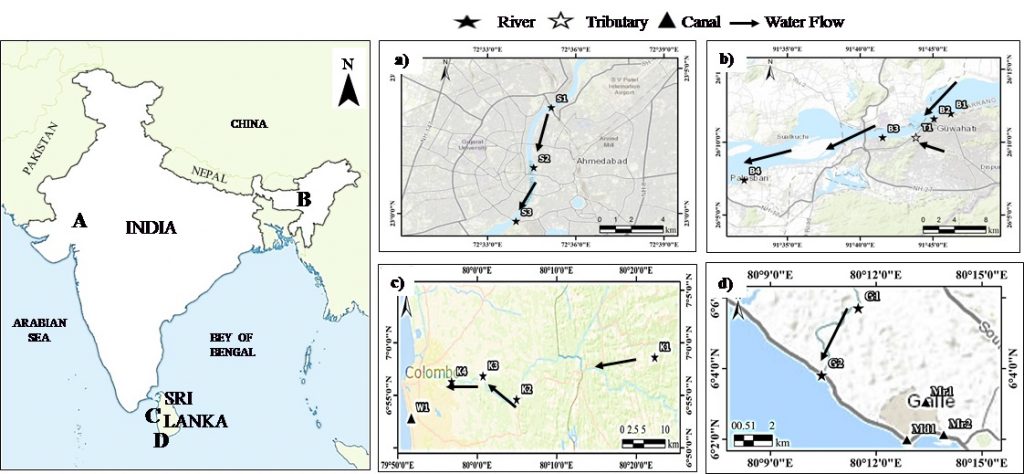
2.2 Analyses
Surface water locations in India and Sri Lanka (Fig. 1) were selected based on the preliminary survey of in-situ parameters (Hanna 981A) like pH, Total Dissolved Solids (TDS), Oxidation-Reduction Potential (ORP), Electrical conductivity (EC), Dissolved Oxygen (DO), Temperature and Salinity strategic sampling locations in each city were selected. In general, the rivers were sampled before, during and after entering in the urban areas. Locations with confluence points of major drains were also sampled. Sampling locations are shown for the Sabarmati River (S1-S3) (Fig. 1a), Brahmaputra River (B1-B4) and Bharalu tributary (T1) (Fig. 1b), Kelani River (K1-K4), Wellawatta Canal (W1) (Fig. 1c), Gin River (G1, G2) Moda Ela (Md1) and Moragoda Ela (Mr1, Mr2) (Fig. 1d). Metals were analysed by ICPMS (PerkinElmer’s NexION® 2000). To ensure quality control, blanks were prepared for the dilution buffer, monitor kit, and media.
2.2.1 Isolation of E. coli
Strains of E. coli were isolated and separated from water samples using a membrane filtration method. E. coli colonies were identified by staining. The number of E. coli colonies per mL of water sample (cfu ml-1) was obtained by counting dark blue colonies and other coliforms by counting pink to red colonies. The total coliform count is the sum of E. coli and other coliforms.
2.2.2 Antibiotic susceptibility
The isolated E. coli colonies were evaluated for resistance to fluoroquinolones [norfloxacin (NFX), ciprofloxacin (CIP), levofloxacin (LVX)], aminoglycosides [kanamycin monosulphate (KM)], tetracyclines [tetracycline (TC)], and sulfonamides [sulfamethoxazole (ST)] using the KB disk diffusion method (Honda et al., 2016). The diameter of growth inhibition of E. coli colonies on the plates was used to estimate the level of resistance.
2.2.3 Screening for antibiotic resistance genes (ARGs)
Two litres of water were collected in sterile plastic pouch bags at each sampling site and kept cold during transport to the laboratory. Upon arrival, samples were filtered through polycarbonate membrane filters. The filters were then soaked with 500 µL of 2X DNA/RNA shield (ZymoResearch, USA) for DNA preservation. The DNA was extracted using the FastDNATM spin kit for soil following the kit protocol (MP Biomedicals, LLC, Ohio, USA). The quantity and purity of the extracts were measured by the absorbance method (Eppendorf, Germany). DNA samples had absorbance ratios of λ260/λ280 ≥ 1.78. Antibiotic resistance genes were amplified by polymerase chain reaction (PCR). The PCR was performed in a thermal cycler (BioRad 2720) for 30 cycles. Six classes of ARGs were selected based on antibiotic mechanisms using specific primers.
2.2.4 Climate models
Two models were selected from among 61 climate change prediction models provided by the Coupled Model Inter-comparison Project, Phase 5 (CMIP5) through the Data Integration and Analysis System (DIAS). Reproducibility of each model was evaluated with regards to the average precipitation for May to October of the 1979-2005 wet seasons (10N-30N, 70E-100E). CSIRO and MIROC5 were selected as climate change prediction models by comparing correlation coefficients for the GPCP data. The used output of the models is based on the representative concentration pathways scenario at a radiative forcing of 6 W/m2. This condition is considered the global warming effect with atmospheric CO2 increase. Model output data were extracted for 1981 to 2000 through the DIAS server. The 24 × 36 grids output of all precipitation in the target area (24N-30N, 88E-97E) was extracted with 0.25-degree resolution. Also, the past reproduction data of air temperature (24 × 36 grids) was extracted with a 0.25-degree resolution, but we could extract the air temperature (6 × 9 grids) for the future with a coarse resolution of 1 degree.
2.2.5 Statistical analyses
SPSS 21 (IBM) was used to carry out principal component analysis (PCA) and hierarchical cluster analysis (HCA) after normalization by obtaining z-scores for each parameter. Varimax rotation, an orthogonal mode of rotation, was used to generate non-related principal components. Results were represented in a 3-dimension PCA diagram. Cluster analyses were conducted using the Ward method to show proximity among analysed parameters.
3. Results and Discussion
3.1 Prevalence of E. Coli, antibiotic resistant bacteria (ARB) and antibiotic resistance genes (ARGs)
The prevalence of E. coli ranged from 10-27 cfu ml-1 in the Kelani River, 24,267-76,600 cfu in the Sabarmati and from below detection to 49 cfu ml-1 in the Brahmaputra River. Most E. coli isolates were resistant to multiple antibiotics, and the resistance percentage was higher for older generation antibiotics like tetracycline and sulfamethoxazole. The Brahmaputra River showed higher resistance to all antibiotics than the Sabarmati, Kelani and Gin rivers. However, resilience was also highest in the Brahmaputra River owing to its dilution capacity and processes like sedimentation, adsorption, photodegradation and microbial-mediated activities (Fig. 2). Two sites of the Brahmaputra River within Guwahati city exhibited near 100% resistance to all antibiotics except tetracycline, which is a severe environmental health concern.
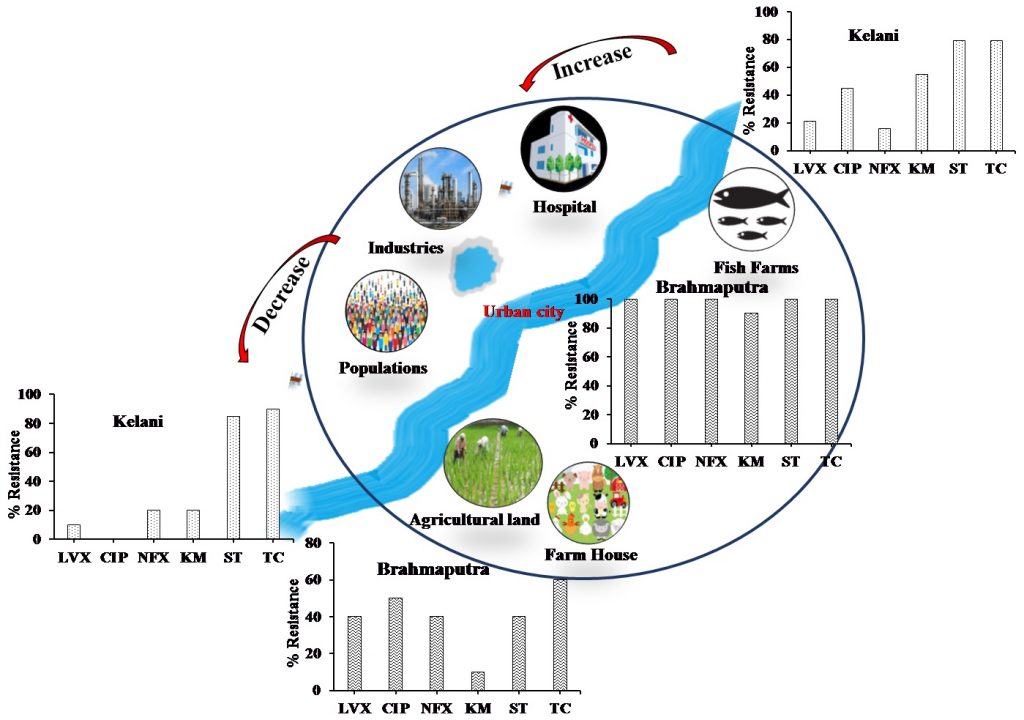
The antibiotic resistance genes gyrA, tetW, sul1 and ampC were detected in the Kelani River, while aac-(6’)-1b-cr, gyrA, tetW, sul1, ampC and blaTEM were found in the Brahmaputra River. ARGs dfr1, blaCTX, qnrS, vanA, parC, qnrB and blaSHV were not detected in any Kelani or Brahmaputra samples. The trend in metal concentrations was Cr>Ni>Mn>Zn>Cu>Pb>Co>Cd in the Kelani and Brahmaputra Rivers and Cr>Ni>Mn>Cu>Pb>Co>As>Cd>Zn in the Sabarmati River. Overall, both Brahmaputra and Kelani rivers showed vulnerability while passing through an urban area as well as resilience through dilution of metals, faecal pollution, ARB, and ARGs.
3.2 Prevalence of ARB and ARGs in Sri Lankan wastewater with reference to India
Although wastewater treatment resulted in greater than a 1.06 log reduction in E. coli at all WWTPs, the percentage of E. coli resistant to most of the antibiotics increased from influent to effluent. ARB, ARGs and multidrug resistance, were more prevalent in hospital WWTP owing to higher antibiotic concentrations used and excreted by patients. WWTPs in Sri Lanka showed more ARB than India, with consistent increases after treatment, but were less resistant to fluoroquinolones. In both countries, almost all sampling points contained E. coli strains with multidrug resistance, which increased after treatment (Fig. 3), and was strongly correlated with fluoroquinolones in every WWTP. Fluoroquinolone resistant genes (aac-(6′)-1b-cr, qnrB, qnrS), β-lactams (ampC), and sulphonamides (sul1) were detected in municipal WWTPs with additional genes for parC in the hospital wastewater of Sri Lanka, implying much higher resistance to fluoroquinolones, especially ciprofloxacin.

Multivariate analysis suggests effluent showed higher loadings and association for ARB and multidrug resistance where pH change and longer interaction with metals during the treatment processes seem to have profound effects.
3.3 Occurrences of PPCPs and viruses
Samples from the Brahmaputra (n=4), urban drains (n=3), and the Ramsar site Dipor Bil (n=1) exhibited an order of prevalence for PPCPs: caffeine > acetaminophen > theophylline > carbamazepine > crotamiton and for enteric viruses as PMMoV > aichi > hepatitis A > norovirus GII > norovirus GI (Fig. 4). PMMoV was an effective indicator of faecal pollution due to its prevalence, specificity and ease of detection. The prevalence of PPCPs among samples was similar to faecal bacteria and viruses (Kumar et al., 2019). PPCP concentrations were high in drain samples and very low in lake and river water. PPCPs are directly associated with raw sewage and thus were not detected in the upstream or downstream of the Brahmaputra, owing to self-purification of the river. PMMoV was the only virus detected in all river samples. Cost-effective technologies are needed to reduce levels of resistant genes in drinking water systems. Research on the bacterial strains in biofilms within water network systems is critical to understand and manage selection pressure stemming from treatment methods that enhance resistance.
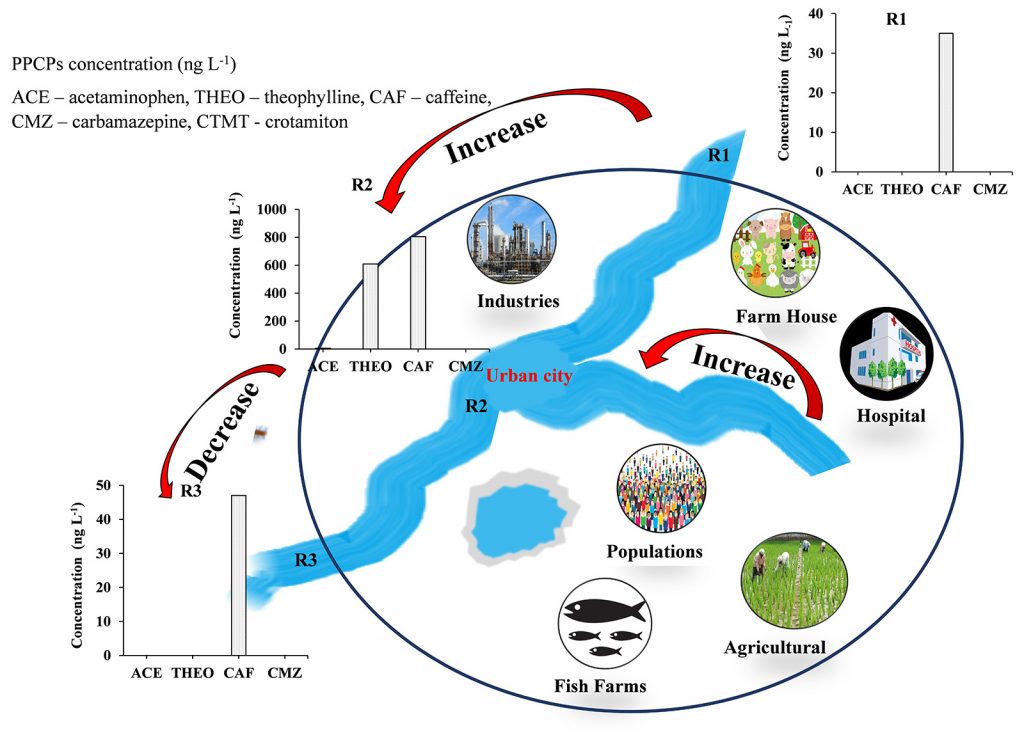
3.4 Associations among conventional and emerging water quality parameters
PCA loading (Fig. 5a) and HCA clustering (Fig. 5b) suggest associations of faecal contamination (coliform) with electrical conductivity (EC), carbamapzine concentration, and hepatitis and norovirus count. Norovirus and PMMoV were associated with caffeine, acetaminophen and Zn. The pH, ORP and metal concentration likely control these associations. It further implies that people seem to be suffering more from temperature and monsoon-driven diseases like intestinal infection and cholera as well as the common cold and flu. Emerging contamination has no direct correlation with conventional parameters like pH, ORP or metals, as emerging contaminants are present in very trace quantities that probably do not affect these parameters. It further suggests that vulnerability of the water system cannot be assessed based on traditional water quality parameters and must include new indicators such as PMMoV, caffeine, carbamapzine and acetaminophen. Estimation of both labile and conservative PPCPs are equally important. It is time to adopt a holistic approach to the evaluation of vulnerability and resilience of water systems as well as to revise the ambient water quality guidelines by including new age parameters.

3.5 Climate trends and scenarios in the Brahmaputra watershed
Disruption of river flows and the fate of contaminants can reduce dissolved oxygen levels and changes in chemical reaction kinetics, enhance potential for toxic algal blooms, and may cause the migration and extinction of aquatic animals. These are some of the impacts of climate change on temperature and rainfall. Thus, understanding and predicting climate change impacts are of utmost importance to take necessary measures. Temperature and precipitation in the Brahmaputra region were reproduced by CSIRO–Mk3.6 and MIROC5 (Fig. 6). Average precipitation predicted by both models for present and future scenarios was similar (1200-1300 mm), but the magnitude of extreme events (floods and droughts) was different. Maximum and minimum precipitation predicted by the CSIRO model were 2000 mm and 800 mm, respectively, whereas by the MIROC model, these values were 2000 mm and 750 mm (Fig. 6). Yearly variation in precipitation is not much, but there are quite a few monthly variations. The CSIRO model predicted a decrease in maximum monthly precipitation and number of rainfall months. With the MIROC model, the maximum monthly precipitation for both present and future years is more or less the same and the number of rainfall months remain the same.

There has been an increase in temperature of approximately 1.5 °C over the past 50-60 years. Both models showed an increase in yearly temperature relative to the temperature of past years. However, temperatures predicted by the CSIRO model were comparatively higher than by the MIROC model. Monthly temperature prediction also showed the same pattern with both models. The CSIRO model indicates that temperature may rise as high as 38 °C while the high is 32 °C with the MIROC model. Overall, the temperature is predicted to increase, with maximums and minimums for current and future years of 29 °C and 30 °C, and 27 °C and 28.8 °C, respectively. Temperature and precipitation predictions by MIROC may be more accurate than CSIRO based on root mean square errors of 3.3 (MIROC5) and 4 (CSIRO).
The most pertinent question is how the scenario of projected population growth and land-use change will impact water quality vulnerability, treatment resilience, and cope with changes due to climate change. Importantly, how will all of this impact the livelihood of people residing in these areas? Some likely changes may be reflected in terms of inundation and more sewer overflow contaminating water resources. Further, as photodegradation is a significant pathway of PPCPs degradation and bacterial growth diminishes at lower temperatures, it is likely that with increasing temperatures owing to climate change there will be an associated increase in bacterial growth and breakdown of PPCPs, implying some future influence on the resistant capability of microbes.
3.6 Resilience strategy and framework for both watersheds
To prepare a resilience strategy and framework, the previous master plan for Guwahati city and people’s perceptions were evaluated. A sample of 110 households (414 people) was surveyed for public perception and awareness of environmental pollution and water use.
3.7 People’s perception
This survey had aimed to assess the quality of life conditions and perceptions of present environment pollution and satisfaction with its management (Fig. 6 a to d). Overall, people were well aware of water supply limitations and had faith in the public health department in that, without the proper treatment, they would not supply water to the population. People were informed about household filters that can help avail safe potable water, but awareness of emerging contaminants was much less.

Only 11% of people suggested that disinfectant should be used for water treatment. Illiterate or less educated people had an inadequate understanding of health risk caused by environmental and/or water quality problems. However, most people preferred groundwater for drinking purposes rather than tap water. Perception and awareness regarding various indirect issues including biomass burning and lifestyles not perceived by the public as being directly linked to water management, needs to be positively instilled in a meaningful manner for which a roadmap is required (Kumar et al., 2019).
3.8 Roadmap 3030: Vision for future decisionmakers
Table 1 is divided into four major sections with demarcation of actions. Some key actions recommended for sustainable management of rivers are:
- Continuous monitoring of the river and tributaries for pollution load, as on-going assessments are required for management.
- Educate people to segregate waste at the source and provide incentive and/or recognition, at least initially. Include this in the education syllabus for children and allocate resources to help the public understand its importance.
- Provide proper waste collection systems, as no one wants to segregate waste if it is later mixed and their efforts wasted.
- Develop strict rules and policies for industrial wastewater discharge backed with robust local community effecting monitoring and implementation.
- Building WWTPs should be the responsibility of each institution and ward. Decentralized management is essential.
- Proper guidelines for permissible limits in discharge water should be developed and implemented.
- Provide tax incentives for incinerators or composters for effective waste management.
- Develop SMS (solid waste management system) application/app to report waste mismanagement, lodge complaints and receive feedback. Education can be included with instruction on simple techniques.
- Use waste materials in constructing roads and pavements and apply new technologies (e.g. construction of green buildings and soil-less farming).
- Increased navigation, inland water transportation and river tourism would lead to the cleaning of the river by dredging.
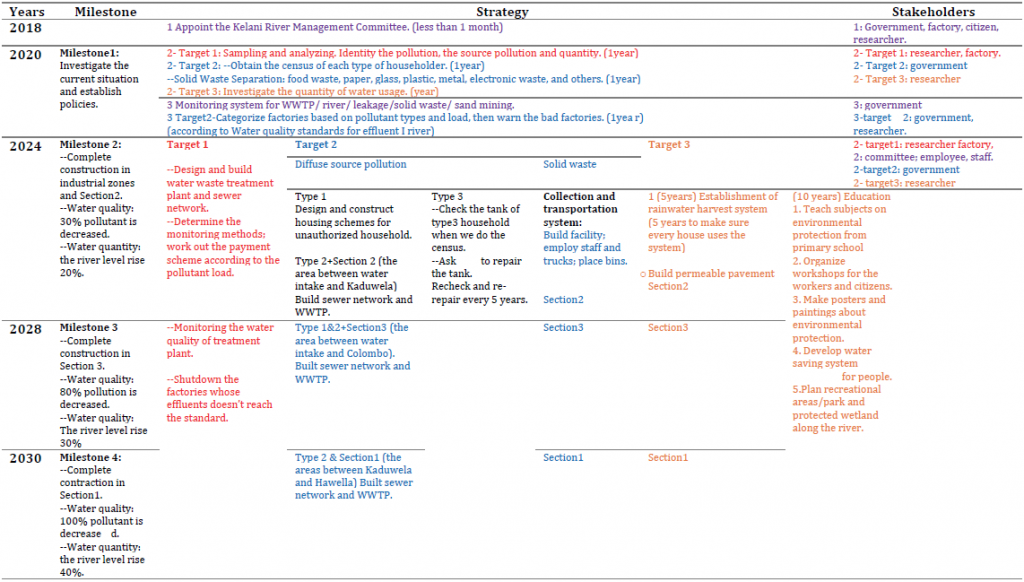

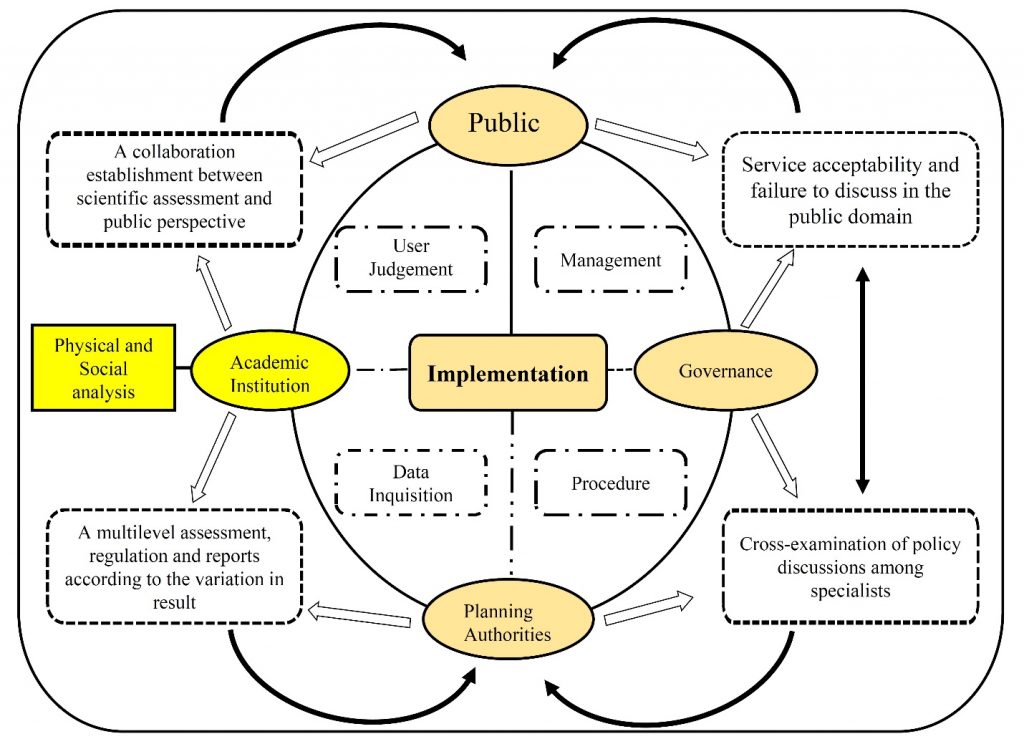
4. Conclusion
A multi-disciplinary approach requires the participation of scientific experts, engineers and architects, designers, planners, researchers and social scientists (Fig. 9) (Kumari, 2019). Local communities also need to be involved to ensure everyone has a voice. Guwahati and Colombo have many common problems and thus similar needs. Both cities need to enhance voluntarily public participation by frequently organizing authoritial events. Such events should firstly address social aspects and establish committees with varied expertise. Furthermore, everyone involved must understand that water resources are limited, and depend on the efficient functioning of “unlimited loops” (Fig. 10). Thus, assessment of emerging contaminants along with hydrological parameters may lead to the development of a resilience strategy and actionable framework for environmental safety and sustainability.

Acknowledgements
We owe our sincere gratitude to many numerous researchers, their institutes, government and non-governmental organizations as well as the general public that actively participated to make this article possible, that enlisting all of them won’t be possible here. We would like to express our sincere gratitude to Prof. Latha Rangan, Prof. Chandan Mahanta and Prof. Ajay Kalamdhad for their logistic support at Indian Institute of Technology Guwahati, India. We would like to acknowledge editorial assistance provided by Prof. Patrick J Shea, University of Nebraska-Lincoln, USA. Thank you also to Prof. N. C. Talukdar, Director, Institute of Advanced Study in Science and Technology (IASST), Guwahati. Several workshops would not have been possible if eminent people of all three countries had not attended it. Support from journalists of Times of India was very vital to reaching out to the people and policymakers without which such impact would not have been made. Last but not the least, thank you to Asia Pacific Network that supported this work under Collaborative Regional Research Programme, as well as DST-JSPS fund under India-Japan Co-operative Science Programme under which support from the University of Tokyo, could be achieved.
References
- Bausch, D. G., & Schwarz, L. (2014). Outbreak of Ebola virus disease in Guinea: where ecology meets economy.
- Ferreira da Silva, M., Vaz-Moreira, I., Gonzalez-Pajuelo, M., Nunes, O. C., & Manaia, C. M. (2007). Antimicrobial resistance patterns in Enterobacteriaceae isolated from an urban wastewater treatment plant. FEMS microbiology ecology, 60(1), 166-176.
- Global Antibiotic Resistance Partnership (GARP)-India Working Group. (2011). Rationalizing antibiotic use to limit antibiotic resistance in India. The Indian journal of medical research, 134(3), 281.
- Government of India Ministry of Water Resources. (2002). National Water Policy. New Delhi, India
- Herath, G., & Amaresekera, T. (2007). Assessment of urban and industrial pollution on water quality: Kelani River Sri Lanka. Southeast Asian Water Environment, 2(2), 91-98.
- Honda, R., Watanabe, T., Sawaittayotin, V., Masago, Y., Chulasak, R., Tanong, K., … & Poonnotok, A. (2016). Impacts of urbanization on the prevalence of antibiotic-resistant Escherichia coli in the Chaophraya River and its tributaries. Water Science and Technology, 73(2), 362-374.
- Hsu, J. S. C., Shih, S. P., Hung, Y. W., & Lowry, P. B. (2015). The role of extra-role behaviors and social controls in information security policy effectiveness. Information Systems Research, 26(2), 282-300.
- IPCC. (2014). Climate Change 2014: Impacts, Adaptation, and Vulnerability. Part A: Global and Sectoral Aspects. Contribution of Working Group II to the Fifth Assessment Report of the Intergovernmental Panel on Climate Change. In C.B. Field, V.R. Barros, D.J. Dokken, K.J. Mach, M.D. Mastrandrea, T.E. Bilir, M. Chatterjee, K.L. Ebi, Y.O. Estrada, R.C. Genova, B. Girma, E.S. Kissel, A.N. Levy, S. MacCracken, P.R. Mastrandrea, and L.L.White (Eds.), Cambridge University Press, Cambridge, United Kingdom and New York, NY, USA, 1132 pp.
- Jiang, L., Hu, X., Xu, T., Zhang, H., Sheng, D., & Yin, D. (2013). Prevalence of antibiotic resistance genes and their relationship with antibiotics in the Huangpu River and the drinking water sources, Shanghai, China. Science of the Total Environment, 458, 267-272.
- Klein, E. Y., Van Boeckel, T. P., Martinez, E. M., Pant, S., Gandra, S., Levin, S. A., … & Laxminarayan, R. (2018). Global increase and geographic convergence in antibiotic consumption between 2000 and 2015. Proceedings of the National Academy of Sciences, 115(15), E3463-E3470.
- Kühn, I., Iversen, A., Finn, M., Greko, C., Burman, L. G., Blanch, A. R., … & Domínguez, L. (2005). Occurrence and relatedness of vancomycin-resistant enterococci in animals, humans, and the environment in different European regions. Appl. Environ. Microbiol., 71(9), 5383-5390.
- Kumar, M, Ram, B., Honda, R., Poopipattana, C., Canh, V. D., Chaminda, T., & Furumai, H. (2019) Concurrence of Antibiotic Resistant Bacteria (ARB), Viruses, Pharmaceuticals and Personal Care Products (PPCPs) in Ambient Waters of Guwahati, India: Urban Vulnerability and Resilience Perspective. Science of the Total Environment, 693, 133640. doi: 10.1016/j.scitotenv.2019.133640
- Kumar, M., Snow, D. D., Li, Y., & Shea, P. J. (2019). Perchlorate behavior in the context of black carbon and metal cogeneration following fireworks emission at Oak Lake, Lincoln, Nebraska, USA. Environmental Pollution. 253, 930-938.
- Kumar, M., Rao, M. S., Kumar, B., & Ramanathan, A. (2011). Identification of aquifer-recharge zones and sources in an urban development area (Delhi, India), by correlating isotopic tracers with hydrological features. Hydrogeology journal, 19(2), 463-474.
- Kumar, M., Herbert, R., Ramanathan, A., Deka, JP., Rao, M. S., & Kumar, B. (2013). Hydrogeochemical zonation for groundwater management in the area with diversified geological and land-use setup. Chemie der Erde- Geochemistry, 73, 267-274.
- Kumari, O. (2019). Urban Vulnerability, and Resilience Strategy in Guwahati, Assam: Framework for Implementation of Environmental Planning. (Unpublished masters thesis). Indian Institute of Technology Gandhinagar, India.
- Kümmerer, K. (2009). Antibiotics in the aquatic environment–a review–part I. Chemosphere, 75(4), 417-434.
- Liyanage, C., & Yamada, K. (2017). Impact of population growth on the water quality of natural water bodies. Sustainability, 9(8), 1405.
- Mahagamage, M. G. Y. L., Chinthaka, S. D. M., & Manage, P. M. (2016). Assessment of water quality index for groundwater in the Kelani river basin, Sri Lanka.
- Pervez, M. S., & Henebry, G. M. (2015). Assessing the impacts of climate and land use and land cover change on the freshwater availability in the Brahmaputra River basin. Journal of Hydrology: Regional Studies, 3, 285-311.
- Sanders, C. C. (2001). Mechanisms responsible for cross-resistance and dichotomous resistance among the quinolones. Clinical Infectious Diseases, 32(Supplement_1), S1-S8.
- Sayah, R. S., Kaneene, J. B., Johnson, Y., & Miller, R. (2005). Patterns of antimicrobial resistance observed in Escherichia coli isolates obtained from domestic-and wild-animal faecal samples, human septage, and surface water. Appl. Environ. Microbiol., 71(3), 1394-1404.
- Van Boeckel, T. P., Brower, C., Gilbert, M., Grenfell, B. T., Levin, S. A., Robinson, T. P., … & Laxminarayan, R. (2015). Global trends in antimicrobial use in food animals. Proceedings of the National Academy of Sciences, 112(18), 5649-5654.